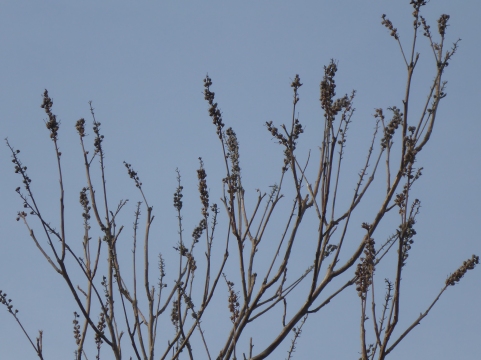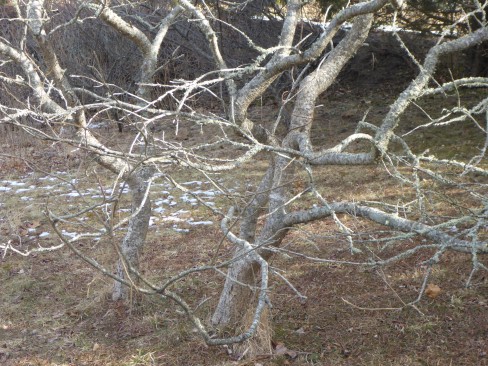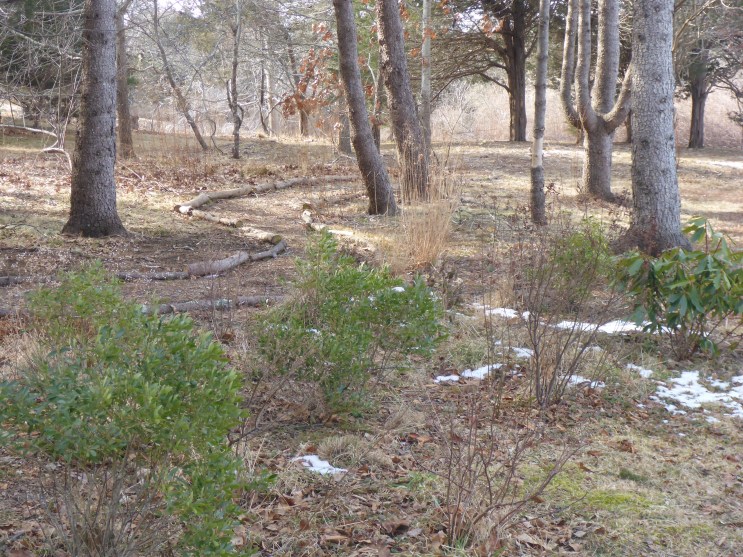I’m not going to tell you this is the most picturesque time in the garden. There are garden beds that are flat and empty, and gray and brown colors predominate. But I still enjoy walking around the garden and seeing what looks interesting. Here’s what I found on a recent walk.
Spots of color
Beyond the conifers and rhododendrons, there are a few plants that remain green and even show a bit of color. One of the more interesting is the non-native skimmia (Skimmia japonica), a low-growing and spreading shrub that serves as a great foundation planting on either side of my front door.


It flowers in the late winter/early spring, with tiny pink clusters at each growing tip. The male plant is the showier of the two, but the female plant still has a few of last year’s berries alongside this year’s flowers. I’m guessing this must be a wind-pollinated plant, as there are no insects around this time of year.
Along the front fence is a native cultivar, a variegated leucothoe (I believe it is a cultivar of Leucothoe axillis). I love the yellow and green patterned leaf, with the reddish tinge to the stems. This time of year I make a special point of walking over and admiring it.

It’s always fun to have a winter-blooming plant in the garden. Here is mine, a non-native member of the heath (Erica spp) family. It was in full bloom on a late February afternoon:

Stems and Seeds
In the fall, my yard cleanup is very selective – I aim to leave most of the stems and seed heads in the garden until spring. This is for two reasons: most important, many insects and pollinators use these leftover structures as a place to over-winter. By leaving them up, I am helping retain them in my local ecosystem. Also, I like to look at the more interesting stems and seed heads all winter.
The Pollinator Border mostly stays uncut until mid-spring, when I can hear that there are insects buzzing about. Then it’s OK to cut down the stems. In the meanwhile, this little bluestem grass(Schizachyrium scoparium) below makes an interesting shape.


Another perennial I always leave over the winter is the sedum ‘Autumn Joy’ (Hylotelephium ’Herbstfreude’ Autumn Joy). Although it’s not native, pollinators love it during the late summer. In winter, I admire the sturdy stalks and bushy flower/seed clusters when there is little else to look at.
The sweet pepperbush (Clethra alnifolia) keeps the “peppers” from its seeds all winter. Besides making this shrub easy to identify in the winter, they make interesting patterns against the snow and the sky.


Tree Trunks and Structure
This is the best time of year to appreciate the shapes and textures of the trees in the yard. Here is the rough bark and interesting branching of a crabapple tree, and the twisted shape of a winged sumac (Rhus coppalina).


And it’s a good time to evaluate the overall layout of the paths and beds in the woodland garden and begin scheming for the upcoming spring planting season.

Cathy,
Super job. Congrats.
I wasn’t able to “reply above this line”.
Hugs,
Dave
LikeLike
Loved the new post and pictures, and especially the commentary. It’s true. There is a lot to see in the winter garden. We strolled ours this afternoon, on the first sunny day in a long time, and saw some lovely plants getting ready to bloom here in Charlotte. Thanks for the new post, Cathy!
LikeLike